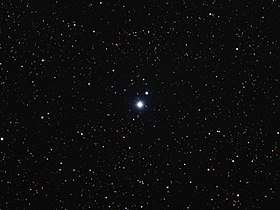Nu Geminorum
Nu Geminorum (ν Gem) is a binary, and possibly a multiple[3] star system in the constellation Gemini. It has an apparent visual magnitude of 4.16,[2] which is bright enough to be visible to the naked eye on a dark night. Based upon an annual parallax shift of 5.99 mas,[1] it is located at a distance of roughly 540 light years from the Sun.
 ν Geminorum in optical light | |
| Observation data Epoch J2000.0 Equinox J2000.0 (ICRS) | |
|---|---|
| Constellation | Gemini |
| Right ascension | 06h 28m 57.78613s[1] |
| Declination | +20° 12′ 43.6856″[1] |
| Apparent magnitude (V) | 4.16[2] |
| Characteristics | |
| Spectral type | B6 III + B8 III[3] |
| U−B color index | −0.47[2] |
| B−V color index | −0.13[2] |
| Astrometry | |
| Radial velocity (Rv) | +39.4[4] km/s |
| Proper motion (μ) | RA: −6.82[1] mas/yr Dec.: −13.10[1] mas/yr |
| Parallax (π) | 5.99 ± 0.28[1] mas |
| Distance | 540 ± 30 ly (167 ± 8 pc) |
| Absolute magnitude (MV) | −2.2 + −1.2[3] |
| Orbit[3] | |
| Period (P) | 18.75±0.34 yr |
| Semi-major axis (a) | 0.081±0.008″ |
| Eccentricity (e) | 0.297±0.049 |
| Inclination (i) | 72.9±1.4° |
| Longitude of the node (Ω) | 120.9±1.1° |
| Periastron epoch (T) | 1992.57±0.18 |
| Argument of periastron (ω) (secondary) | 228.4±7.6° |
| Details | |
| ν Gem Aa | |
| Mass | 6.4[3] M☉ |
| Luminosity | 1,380[5] L☉ |
| Temperature | 14,100[5] K |
| Rotational velocity (v sin i) | 160[6] km/s |
| ν Gem Ab | |
| Mass | 4.6[3] M☉ |
| Other designations | |
| Database references | |
| SIMBAD | data |
The main components of this potentially multiple star system have an orbital period of 18.75 years and an eccentricity of 0.297.[3] There is much uncertainty in the spectral type, with classifications ranging from a main sequence star to a giant. The spectra indicate the presence of a Be star in the system.[8]
According to the catalogue of stars in the Technical Memorandum 33-507 - A Reduced Star Catalog Containing 537 Named Stars, this star was titled as Nucatai.[9]
References
- van Leeuwen, F. (2007), "Validation of the new Hipparcos reduction", Astronomy and Astrophysics, 474 (2): 653–664, arXiv:0708.1752, Bibcode:2007A&A...474..653V, doi:10.1051/0004-6361:20078357.
- Crawford, D. L.; et al. (1971), "Four-color, H-beta, and UBV photometry for bright B-type stars in the northern hemisphere", The Astronomical Journal, 76: 1058, Bibcode:1971AJ.....76.1058C, doi:10.1086/111220.
- Cvetković, Z.; Ninković, S. (November 2008), "Orbits for two short-period and two long-period binaries", New Astronomy, 13 (8): 587–592, Bibcode:2008NewA...13..587C, doi:10.1016/j.newast.2008.03.005.
- Wilson, R. E. (1953), General Catalogue of Stellar Radial Velocities, Carnegie Institute of Washington D.C., Bibcode:1953GCRV..C......0W.
- Hohle, M. M.; et al. (April 2010), "Masses and luminosities of O- and B-type stars and red supergiants", Astronomische Nachrichten, 331 (4): 349, arXiv:1003.2335, Bibcode:2010AN....331..349H, doi:10.1002/asna.200911355.
- Abt, Helmut A.; et al. (July 2002), "Rotational Velocities of B Stars", The Astrophysical Journal, 573 (1): 359–365, Bibcode:2002ApJ...573..359A, doi:10.1086/340590.
- "nu. Gem". SIMBAD. Centre de données astronomiques de Strasbourg. Retrieved 2016-12-06.
- Silaj, J.; et al. (November 2014), "The Hα Profiles of Be Shell Stars", The Astrophysical Journal, 795 (1): 12, Bibcode:2014ApJ...795...82S, doi:10.1088/0004-637X/795/1/82, 82.
- Rhoads, Jack W. (November 15, 1971), Technical Memorandum 33-507-A Reduced Star Catalog Containing 537 Named Stars (PDF), California Institute of Technology: Jet Propulsion Laboratory, retrieved 2019-01-09.
External links
- Kaler, James B. (January 26, 2007), "Nu Geminorum", stars, University of Illinois, retrieved 2016-12-07.